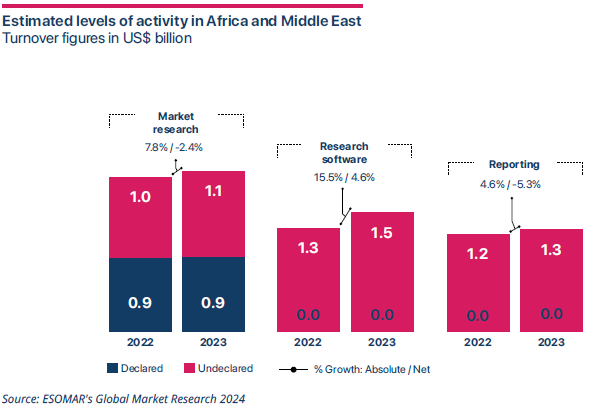Navigating trends and challenges in the Africa and Middle East region
What are the forces shaping market research in the Middle East and Africa?

Article series
Global Market Research
- Drivers of our $142bn insights industry
- 2023’s Market Research Anchor Europe’s Insights Industry
- The Remarkable Ascent of Asia Pacific in Global Insights
- The Economic Awakening of Latin America
- Navigating trends and challenges in the Africa and Middle East region
- Why the demise of tracking cookies signals a win for market researchers
- How are research methods evolving?
- Global evolution of market research projects
- How have study designs evolved in 2024?
- Inside the $153bn Insights Industry
The following article is an excerpt from ESOMAR’s Global Market Research 2024. This flagship report of ESOMAR, often dubbed as the “Bible of Market Research”, provides you with the most comprehensive overview of the state of the insights industry and the market research sector around the world using data collected by national research associations, leading companies, independent analysts, and ESOMAR representatives.
Middle East and Africa displayed comparatively high inflation rates, which challenged an otherwise rising industry. The industry’s promising growth in absolute terms, second highest globally at 9.2%, turned negative when accounting for inflation at -1.2% in net terms. This showed that the industry in these regions continued to experience difficulties with settling as it encountered a variety of social, economic, monetary, and political challenges.
The fastest-growing sector, like for the rest of the regions, was research software with an absolute growth of 15.5%. This sector was the only one to remain positive even after factoring in inflation.

Africa
According to Dharmendra Jain, the African market research industry was thriving, driven by an increasing demand for data-driven insights. This surge is underpinned by several key trends:
Technological advancements
AI, mobile technology, and other innovations are revolutionising market research. With robust mobile and internet penetration, technology-enabled research offers cost efficiency, quality, and speed, making it a preferred choice.
Emergence of global players
Africa is attracting global research technology platforms, with major players setting up regional offices. This influx enhances service delivery and diversifies offerings, bringing the continent closer to global standards.
Traditional vs. online methodologies
While traditional face-to-face data collection remains dominant, online methodologies are slowly gaining traction. Clients, often constrained by budgets, are increasingly conducting in-house research for design, analysis, and reporting.
Diverse research practices
Quantitative research, mainly driven by industry giants, is crucial for strategic insights. Meanwhile, smaller boutique agencies excel in qualitative research. Key domains such as brand, innovation, retail, customer experience (CX), and media research continue to thrive alongside social research bolstered by extensive monitoring and evaluation programs.
GCC
In the Gulf Cooperation Council (GCC) region, John Presutti and Zahia Boumaiz highlighted the promising long-term growth prospects, fueled by economic diversification efforts. Despite the challenges, the GCC’s long-term growth prospects remain promising due to several factors:
Economic Diversification: GCC countries actively diversified their economies beyond oil dependence, emphasising sectors such as tourism, technology, renewable energy, and sustainable development.
Government Initiatives: Significant investments in infrastructure development, digital transformation, innovation, and sustainable practices create opportunities across various sectors.
Large Youth Population: The GCC’s young and tech-savvy population serves as a substantial consumer base, supporting businesses that leverage data-driven marketing strategies with a sustainability focus.
Overall, ESOMAR continues to encourage countries in these regions to study their local markets to understand the local context, better defend the interests of the players in each country, and properly place the region within the global context.
Are you interested in knowing how Africa and the Middle East are performing in the insights industry? Download the latest edition of Global Market Research now!
Xabier Palacio
Head of Intelligence, Advocacy and Standards at EsomarXabier guides the creation of influential studies, reports, and guidelines at ESOMAR while overseeing the Departments of Professional Standards, Intelligence, and Public Affairs. He leads efforts to provide industry insights, maintain ethical standards, and advocate for the sector’s interests. ESOMAR, a global hub for research, insights, and analytics since 1947, supports over 50,000 professionals and companies worldwide. Under Xabier’s leadership, these departments ensure the industry’s continued growth, fostering collaboration and advocating for responsible practices with regulators and legislators.
Originally from Spain, Xabier has been living in the Netherlands for a number of years, where he studied a Master in International Economics followed by a Master in Marketing at the Erasmus University of Rotterdam. He is fluent in Spanish and English, has a decent command of Dutch, and loves music about as much as analysis.
Article series
Global Market Research
- Drivers of our $142bn insights industry
- 2023’s Market Research Anchor Europe’s Insights Industry
- The Remarkable Ascent of Asia Pacific in Global Insights
- The Economic Awakening of Latin America
- Navigating trends and challenges in the Africa and Middle East region
- Why the demise of tracking cookies signals a win for market researchers
- How are research methods evolving?
- Global evolution of market research projects
- How have study designs evolved in 2024?
- Inside the $153bn Insights Industry


